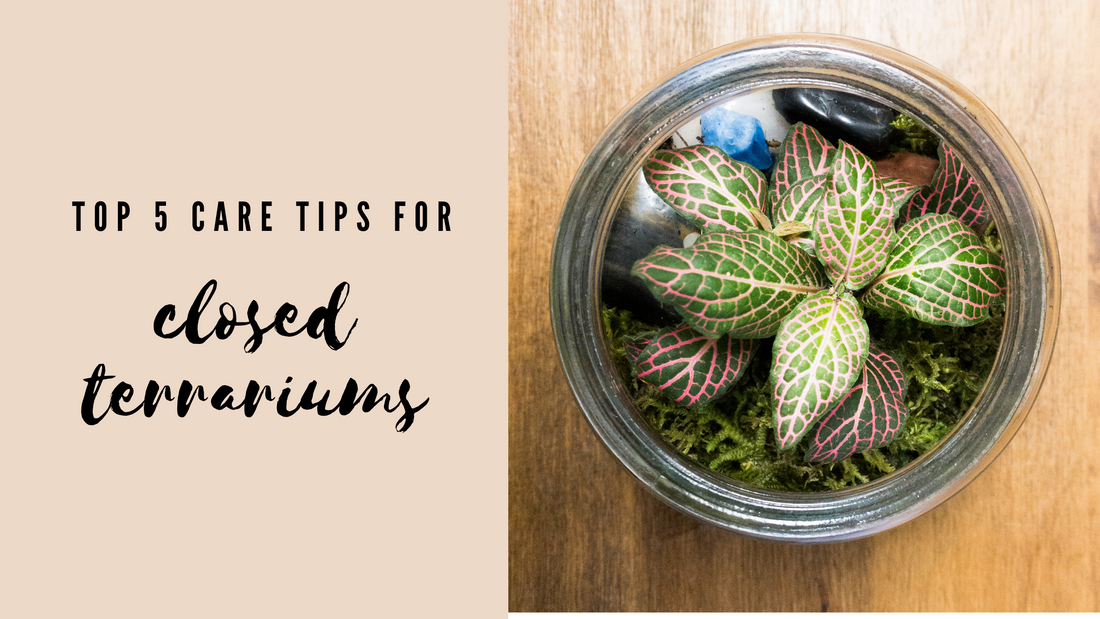Terrarium life is very different from conventional potted houseplants, and it can feel like a huge learning curve to overcome when just starting out. For starters, a closed terrarium is a self-sustaining ecosystem. Both the air and water are recycled over and over, sustaining life in a mutually beneficial environment. For this reason, many growers find terrariums easy to care for and low maintenance, once they are properly set up.
When you are ready to get your hands dirty and take part in this beautiful and serene miniature landscape, check out our DIY terrarium kits. We ship everything you need to your door to assemble your very own closed terrarium, with simplified steps to set up on your own. Follow these guidelines to set up your terrarium and keep the ecosystem happy and healthy!
1. Drainage Is Key for Closed Terrariums

The number one threat terrariums face is overwatering and root rot. Since excess water cannot drain out of the vessel, it is crucial to establish a drainage layer for water to collect on the bottom.
In our terrarium kit, we send out four soil layers to add in the following order: (1) base rocks, (2) activated charcoal, (3) sphagnum moss, and (4) potting soil. By establishing these four layers in this order, water collects on the bottom and is drawn away from the roots. The roots of the plants grow and receive the water they need, without being waterlogged or swampy.
2. Water Your Closed Terrariums Sparingly

Echoing the importance of a drainage layer, it is also important not to add too much water to the terrarium. Unfortunately, the exact quantity and frequency of water needed depends on several factors: size, type of enclosure, amount of plants, amount of light, etc. There is no straightforward, one-size-fits-all answer for how much water to give and how often. However, most closed terrariums only need a small amount of water every three months.
To water your terrarium, use a spray bottle and spray water down the glass sides, allowing the water to cascade down. Only use a spray bottle or mister, and do not pour the water in. Continue until the top layer of soil is wet but not waterlogged.
Terrariums are designed to keep reusing the water they are given. After watering, you should not have to repeat the process for at least a few weeks or months, if at all.
3. Add Tropical Plants to Your Closed Terrariums

The best plants suited for a closed terrarium fit these two criteria: compact and humidity loving. Terrariums are often tiny, so large plants physically will not be able to fit. (We have two closed terrarium sizes available: 22 oz and 76 oz options). Second, closed terrariums are warm year-round and have high humidity, which tropical houseplants will appreciate the most. For these reasons, cacti and succulents are not ideal candidates for closed terrariums, as they thrive in dry and arid climates.
The options for terrarium plants are endless, and there are well over hundreds of different plants grown in terrariums every day. Some great options to start with are the Fittonia “Nerve Plant”, the Calathea Ornata “Pinstripe Plant” (but we love all Calathea plants!), and the Monstera Adansonii “Swiss Cheese Vine”. The list goes on and on, and there is more than enough room to be creative and unique with your plant options.
4. Closed Terrariums are Self-Sustaining

As tempting as it is, do not open the lid until it is necessary. A closed terrarium is its own ecosystem, and it needs very little outside input to grow. Ideally, the lid should stay closed unless something needs to go in or out (i.e. adding a new plant or cutting off an old branch). If you are regularly opening the lid to help the terrarium “breathe”, you are taking away the integrity of the terrarium to do the job itself. Just sit back and enjoy the process, even if it is easier said than done.
5. Check-In Once in a While

Routine maintenance for closed terrariums most often includes checking for dead or overgrown foliage. If one of your plants has dropped some leaves, feel free to open the lid and remove the dead foliage. If there are any rotten plants, remove them immediately before the infection spreads to other plants.
In a similar vein, you may find that your plants are overgrowing the space. If one of your plants is becoming too large, feel free to trim it back. Pruning your plants encourages the existing foliage to become larger and stronger, and for most plants, the cuttings can be propagated in water to grow more plants!
At first, setting up a terrarium for success can sound scary and difficult. Luckily, independent closed terrariums are meant to be low-maintenance and are the perfect fit for beginners. Once you are ready to make the leap, order your own fully-equipped DIY closed terrarium kit and let’s get started!

